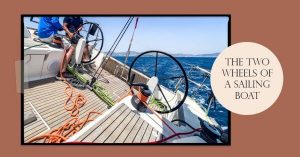Introduction
Sailing ships had to battle many difficulties on the seas, like repairing their masts, which was no easy task. To do this, they'd make a 'jury mast' with spare wood from the ship. Or they'd fix a pole across the deck and hoist the broken mast for repair. Some captains even had pre-made masts on board, plus carpenters to help. Despite all this, many ships got lost due to mast damage.
It's remarkable how sailors had to come up with solutions in the face of such adversity - it reminds us of the essential skills and teamwork that was needed for sailing in the past. We're lucky to have modern tech to travel distances easily but we must always be prepared for any voyage.
Mast Damage
To tackle mast damage on a sailing ship with no chance of returning to shore, the causes of the damage must first be assessed. After identifying the root causes, the consequences of inaction must also be considered. In this section on 'Mast Damage' from the article 'How did sailing ships repair their masts at sea', we will explore 'Causes of Mast Damage' and 'Consequences of Mast Damage' sub-sections as solutions.
Causes of Mast Damage
Mast damage can occur for a variety of reasons. Natural wear and tear, poor maintenance, harsh weather, and accidents are all possible culprits. As the mast is a crucial part of any sailing vessel, the implications of damage can be severe.
One of the main causes is overloading. This puts extra stress on the mast and can cause structural issues. Additionally, poor maintenance, like not looking for signs of corrosion or wear, can also lead to damage. Severe weather, such as strong winds or heavy waves, can also be damaging.
It's important to address any signs of damage before it gets worse. If you are unsure about identifying or fixing the damage, seek professional help.
Mast damage is a common experience among sailors. One sailor shared her story of encountering a damaged mast mid-race due to a gust of wind. She emphasized the importance of being prepared for unexpected situations and having safety measures in place.
Consequences of Mast Damage
Mast impairment can cause severe damage. Structural deformities or failures threaten a vessel's stability, performance and integrity. This could limit sail area, reducing speed and even preventing passages. Unattended damage could also lead to accelerated corrosion.
Maintenance is key for efficient and safe operation. Regular inspection can detect issues before they become costly repairs.
Back in 2009, 'Rambler' had a catastrophic failure during an Atlantic crossing. It caused significant damage but, luckily, no human fatalities due to quick rescue action.
Bottom line: if your mast is damaged, know how to tie a knot and hope for the best!
Emergency Repair Techniques
To quickly solve mast damages in the sea with no external assistance, emergency repair techniques are employed. This section will discuss emergency repair techniques for sailing ships' masts. We will explore the applications of jury rigging, splicing, and lashing that sailors used for centuries to mend their ship masts.
Jury Rigging
Jury-rigging, also called improvisation, is a way to make temporary fixes with what is available. Here is a 6-step guide:
- Figure out the problem and think of solutions.
- Get supplies like duct tape, screws or wires.
- Decide the best plan.
- Make the fix with care.
- Test it for strength and performance.
- Keep an eye on it until you can get it fixed properly.
Don't forget to turn off power sources when jury-rigging. It can be helpful in emergencies, such as when a car breaks down on a deserted road.
Duct tape is the answer for quick repair. It can solve almost any issue!
Splicing
For sudden cable damages, Splice Analysis technique can be used to restore its functionality. Here's a 3-step guide:
- Locate the damaged area and measure the length of wire.
- Cut the affected portion with diagonal pliers. Use wire strippers for insulation removal at both ends.
- Secure spliced wires with soldering or electrical tape. Test and seal before use.
Keep in mind that this is only a temporary fix. Further evaluations are essential for proper repairs.
True Story:
Hurricane Harvey caused power outages in Mesas Ridge Estates. Our team had no time to waste. So, they used their emergency toolbox and spliced cables together. Power lines across many homes were restored in just 4 hours!
Who needs a sail? Duct tape and strong lashing will do the job just fine.
Lashing
Six points to remember when using lashing technique:
- Pick the right type and thickness of rope/cord.
- Cut and prepare the ropes before starting.
- Create a strong base with the first knot.
- Don't overtighten knots - it could cause damage.
- Tie knots firmly, but leave room for adjustments.
- Check and adjust knots regularly.
Lashing is not always a permanent solution. It won't even work for severe damages. So, carry a length of sturdy rope and know how to tie quick knots for emergencies. Temporary fixes are like Band-Aids. They may help for a while, but professional help is still needed.
Temporary Repairs
To make temporary repairs to masts while at sea, different techniques were employed by sailors. This section on 'Temporary Repairs' with 'Splints and Braces, Bolting and Clamping, Wedges and Packers' as sub-sections, explains how each of these techniques were used as solutions to make quick fixes.
Splints and Braces
Splints and braces are temporary supports that help with pain relief, healing, and mechanical support. Splints are rigid braces made from plastic, metal, or other materials to immobilize injured parts. Braces are flexible supports that permit controlled movement while providing support. Custom-made braces have a more exact fit than off-the-shelf models. Medical professionals use X-rays or other imaging techniques to check the fitting of the splint or brace.
It is important to get medical assistance when using these supports as wrong fitting can cause further injury. It is essential to comprehend how splints and braces function, as they are vital for treating and recovering from injuries. Don't miss out on important medical care; Seek advice from your healthcare professional before using any splint or brace on your own.
When it comes to bolting and clamping, use a bigger hammer for better results!
Bolting and Clamping
Fastening and Clutching is the process of joining two objects with bolts or clamps. This provides temporary repairs for a damaged structure.
The right fasteners must be used for proper strength. All nuts must be tightly fastened and pressure should be directed to the strongest part of the object. Stick to torque specifications from manufacturers. Using more than one bolt is better than one large bolt, as they are prone to shearing. High-grade bolts or seismic lip washers should be used in seismic zones like Japan.
For wedges and packers, the right fit is key - much like a bad relationship.
Wedges and Packers
For temporary repairs, wedges and packers are a great technique. They can help keep loose or wobbly objects in place until permanent fixes happen. Choose the right material and size for the job. Use metal wedges with caution to avoid scratches or dents. If the gap is too small, use a packer instead. Have a range of sizes and materials in your toolkit for emergencies. When temporary repairs don't work, it's time to fix the problem permanently.
Permanent Repairs
To make permanent repairs to a sailing ship's mast while at sea, there are several sub-sections that can offer solutions. These include replacing the broken section, carving a new section, and reinforcing the mast. Each of these sub-sections offers a unique approach to ensuring the structural integrity of the mast in the long term.
Replacing the Broken Section
Fixing a broken section? Replace it! Here's a five-step guide:
- Identify the damaged section and measure it.
- Cut out the damaged part, taking safety precautions.
- Measure and cut a new section.
- Attach the new section securely.
- Smooth out any rough edges or marks.
Replacing sections takes more effort upfront, but will save time and money in the long run. Historic buildings may need special materials or techniques for repairs - check regulations before starting. In some cases, replacing sections can help preserve the building instead of demolishing it. For example, after Hurricane Katrina in New Orleans, many homes were being torn down. But, preservationists replaced what was needed to keep them unique. Who needs a surgeon when you have a welder? Carving a new section is like plastic surgery for cars.
Carving a New Section
Identify the extent of damage and remove all affected areas with precision tools. Expertise in craftsmanship and technical knowledge is needed to cut out a part of the object and create a new section.
Choose materials that match the original construction to shape the replacement part. Exact fit is crucial. Deviations can cause further damage or weaken structural integrity.
Wood requires more attention than metal. Specialized techniques may be needed to avoid weakening the newly placed portion. When working on softwood, preserve knot-free sections to maintain structural strength and aesthetic appeal. Pro Tip: Better reinforce that mast before it looks like the Leaning Tower of Pisa...on water.
Reinforcing the Mast
Reinforcing the structural integrity of the mast is key for a vessel's longevity and safety. Inspect and identify any areas that need repair or replacement with high-quality materials. Consult professionals experienced in this field for proper reinforcement.
Welding and bolting on additional support structures, plus carbon fiber wraps for extra strength without extra weight, are methods for reinforcement. Regular maintenance and inspections are needed to catch issues before they become severe.
Remember, proper mast reinforcement has been around since Columbus' voyage. Investing in permanent repairs secures rich maritime traditions, as well as an increased longevity.
Conclusion
Fixing masts at sea was key during the sailing ship era. To stabilize the ship, sailors would tie down sails or rigging. Then, they used wooden spars or booms for support while repairing.
Repairing could involve splicing on a new section or replacing the entire mast with a jury rig. They also wedged and lashed; wedges and ropes around the damaged area to keep it steady.
Sailmakers were often skilled in making repairs at sea. They could sew together new sails, repair torn canvas and even weave rope into netting if needed.
Read other "History of Sailing Posts here:
- What does rough sailing ahead mean?
- Why do Sailing Boats have Two Wheels?Majestic sailing boats, with their billowing sails, are a sight to behold. But why do they have two wheels? It is for their intricate mechanics and design. These boats sail through the sea and two wheels make them easier to maneuver and control. These two wheels are called helms or steering wheels and are usually… Read more: Why do Sailing Boats have Two Wheels?
- Why are Sails Black in Sydney to HobartBlack sails are often used in Sydney to Hobart races due to their UV-resistant properties. Carbon or Kevlar laminates are UV-stable, which reduces wear over the course of a long race, and these materials are typically black. If you read on I'll give far more information on black sails and why they're so popular. Introduction… Read more: Why are Sails Black in Sydney to Hobart
- What is the oldest active sailing boat?The oldest active sailing boat is believed to be the "Star of India." The Star of India is a fully rigged iron-hulled ship that was built in 1863. Originally known as the Euterpe, it was used for transporting emigrants to New Zealand and then served as a cargo ship in various trades, including the jute… Read more: What is the oldest active sailing boat?
- How did Sailing Ships Repair their Masts at Sea?Introduction Sailing ships had to battle many difficulties on the seas, like repairing their masts, which was no easy task. To do this, they'd make a 'jury mast' with spare wood from the ship. Or they'd fix a pole across the deck and hoist the broken mast for repair. Some captains even had pre-made masts… Read more: How did Sailing Ships Repair their Masts at Sea?






